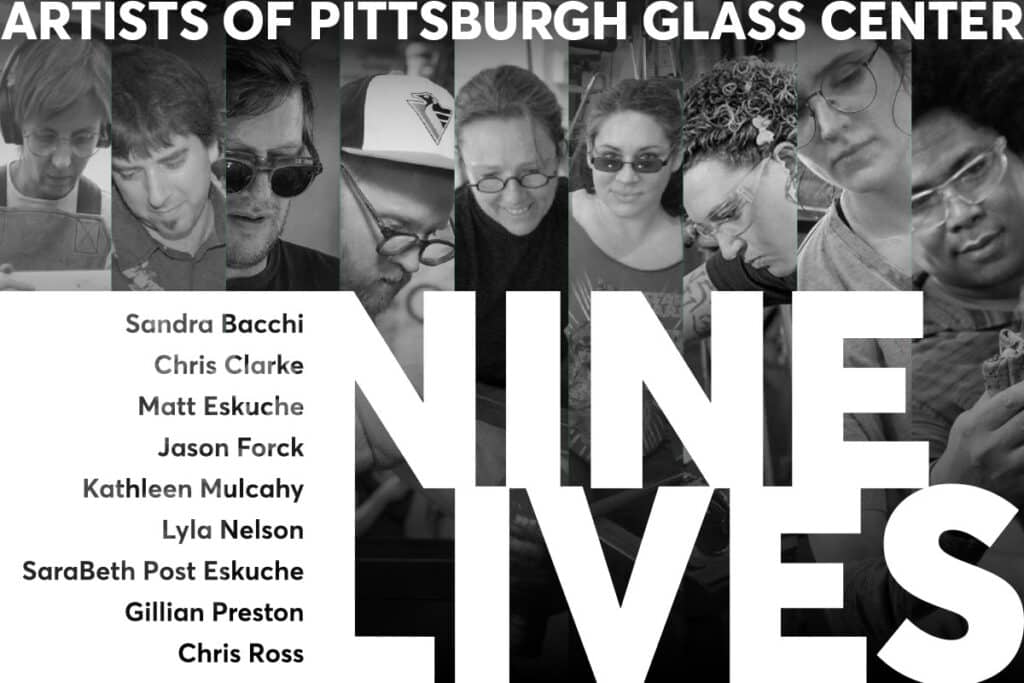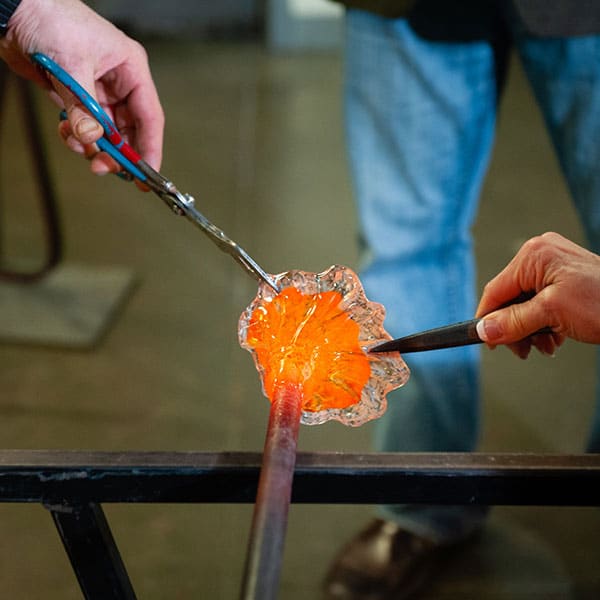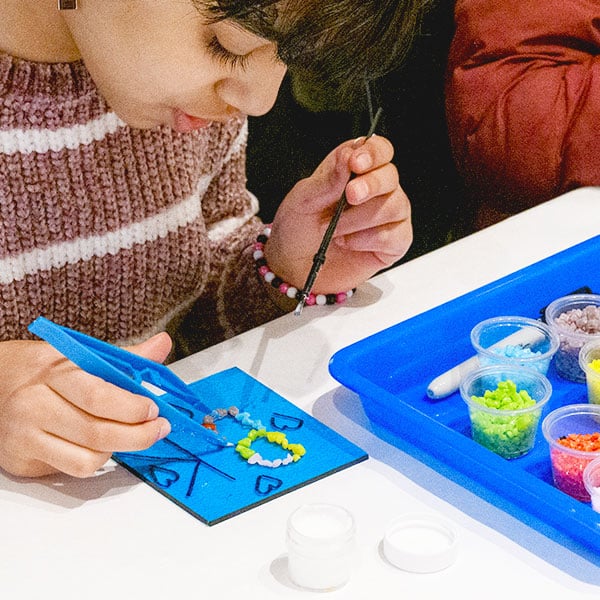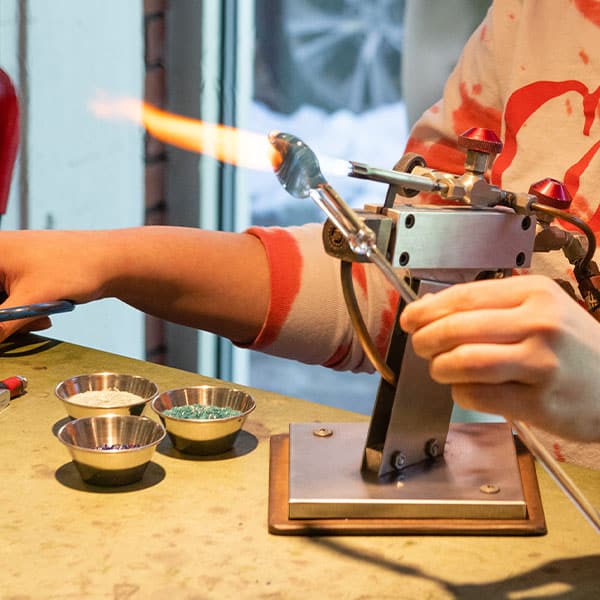Pittsburgh Glass Center: Nine Lives
A special pop-up exhibition at the Seattle Art Fair | July 17–20, 2025
For 25 years, Pittsburgh Glass Center (PGC) has been growing a vibrant community of glass artists. Today that community includes hundreds of glass artists who have moved to Pittsburgh to live and make their art and those who have become passionate about glass by learning and teaching at PGC.
Nine Lives is a special pop-up exhibition at the 2025 Seattle Art Fair that highlights a small selection of glass artists who live and create in Pittsburgh.
Sandra Bacchi
Chris Clarke
Matt Eskuche
Jason Forck
Kathleen Mulcahy
Lyla Nelson
SaraBeth Post Eskuche
Gillian Preston
Chris Ross

About the Artists
Sandra Bacchi
I Find Myself Between Worlds is an ongoing series of layered glass and photographic decal works exploring memory, migration, and identity. Drawing from my experience as a Brazilian-American immigrant, I reflect on the emotional weight of generational stories and the blurred boundaries between past and present. Light, transparency, and suspended forms evoke the passage of time and the fragmented nature of recollection. These pieces hold space for ancestry, longing, and transformation—inviting viewers to consider how we carry and reconstruct memory across borders, cultures, and the shifting landscapes of home.
Sandra Bacchi is a Brazilian-American visual artist based in Pittsburgh, working with photography, glass, and film. Her documentary and conceptual projects merge fiction and truth, crafting open-ended narratives that explore how people find common ground.
Bacchi has exhibited her work nationally and internationally, including at The National Portrait Gallery, Griffin Museum of Photography, and the solo exhibition Watermelons Are Not Strawberries at the Concept Gallery in Pittsburgh, accompanied by a photobook of the same name. Her short film Seeking Nowhere was screened at the Toyama Glass Art Museum in Japan, the Museum of Arts and Design in New York, and the GAS Film Festival.
Bacchi discovered her passion for glass during a 2019 Idea Furnace artist residency at PGC. Her site-specific installation Synergy, permanently displayed in PGC’s main entrance, combines glass and photography to reflect the layered connections between artists, community, and history. Creating a work that honors a place that deeply influenced her has been a tremendous honor. She is proud to contribute to PGC’s mission as a board member (2021–2026).
“When I first walked into Pittsburgh Glass Center in 2019 for an artist residency, I had never worked with glass before. But from the start, the openness, generosity, and creative spirit of the staff made me feel at home. That experience gave me the freedom to take risks and discover how glass could bring dimensionality and depth to my photographic work—adding new layers of meaning to my practice. I was encouraged to experiment, to play, and to imagine beyond what I thought was possible. PGC became not just a creative home, but a place where I began to grow roots in a new city,” she said.
Chris Clarke
Subtle details; that is the inspiration that drives many of my personal interests and ambitions.
I have been a sculptor for the last 25 years, working with glass, metal and wood, specifically glassblowing, blacksmithing, and furniture building. My interests in these materials are rooted in the traditional techniques needed to recreate historical pieces. Along with my artistic creations, comes a deep interest in restoration. I have spent years restoring antique cars, furniture, and recently wooden string instruments.
My free time is divided between creating and nurturing. My inspiration comes from natural surroundings, or the nature I surround myself with. I have been heavily involved with orchid growing and bonsai for years. I currently grow over 30 types of orchids from varying climate zones. Much of my high school and early college years were spent recreating elaborate microclimates to breed rare snakes, lizards, and frogs. The activities I pursue require my awareness and attention to detail. I am an avid fly fisherman, and fly tyer. My fishing interests have led to the study of insect lifecycles for the streams I spend my time on. For every new project I take on I am driven to completely and successfully understand every element and nuance of its complexity.
My most recent work involves sculptural forms derived from studies of nature, specifically shell formations, seed pods, and plant growth habits. By utilizing the physical qualities inherent to glass, I manipulate it to abstractly mimic these forms. The raw glass objects are usually very thick and layered with internal colors. The integration of glass color is very important as I feel it adds the depth necessary to draw the viewer to the object’s interior life. Upon cooling I cold work the glass in order to produce an object that makes known both the sensuous forms found in nature and the abstraction inherent to glass. This vessel represents the union of elegance, fertility, and decay.
Once the glass object is completed to my satisfaction, I utilize forged steel to arrange and present the object as a single cohesive form. Forged steel is, in most cases, not merely a “stand” for the glass but is fully integrated into the object enhancing and amplifying its sensuous nature. Often the steel protectively embraces the glass elements further expressing the balance between protection and seduction in nature.
Chris Clarke was recruited to Pittsburgh Glass Center to help open the nonprofit public access facility. He has been the Director of Operations at PGC since it opened in October 2001. He is responsible for the management, usage, maintenance and improvements of the PGC facility and its technology including computer and phone systems, HVAC, and all studios including two 1,000 furnaces, eight glory holes and over 30 kilns.
He received a BFA in sculpture from Massachusetts College of Art in Boston and a M.F.A in Glass from Kent State University in Ohio. He received the Creative Glass Center of America fellowship in 2000. He has worked as an artist, metal fabricator, and craftsman for over 25 years, and his work has been exhibited at museums and galleries across the country. When he is not in the PGC studios you can find him either restoring his 1910 Arts and Crafts home or fly fishing in Pennsylvania’s beautiful streams.
Matt Eskuche
At age 25 I had the chance to play around with glass and was instantly drawn to the material with delight and intrigue. Then one day, after 6 or 7 years of making pretty objects, I stumbled upon a dented soda can and decided to replicate it. The finished can spoke to me instantly. It was strange. It did not fit in with glass as far as I knew glass… It was an outsider. Everyone I showed it to had a curious face. I started to hear things like “it’s just a can?” or “why would you make something you can just pick up in the street?” I dove in deep, mimicking every piece of trash I could find – water bottles, coffee cups, energy drinks, cigarette packs, beer bottles, fountain cups with lids and straws and ice cubes, you name it.
At first I meant to try to replicate the objects with as much accuracy as my skills would do, but as I made more and more trash, I was finding it unnecessary to follow the strict lines and shapes dictated to me by the actual trash. I became unconcerned with exactness.
The inconsistencies in form, scale, and detail gave the trash its own personality. Each piece of trash was individual, each one strayed in a direction I didn’t quite understand. An inexact object made by inexact hands and an inexact brain. As I’ve witnessed people interact with the trash over the years, I’ve started to see that it exists on its own terms and claims its own ground. It speaks its own voice. People can’t quite place how they feel about it and can’t seem to square it or put in context.
I’m finding out that this mimicry of trash demands deeper thought from the viewer and myself. Making the trash has led me into an interrogation of the life cycle of products made of plastic, glass, aluminum, wood, and paper. I’ve investigated laws and practices revolving around resource extraction, manufacturing processes, advertising, transportation etc. as well as the laws, regulations, lobbying, and other aspects related to the political. I’ve been forced to look more honestly at the impacts these objects of convenience have on labor, the environment, nutrition, and many aspects of human behavior.
This trash glass series has really changed how I see glass and the reasons why I make objects. It’s been a revelation to stumble upon a body of work to pursue that doesn’t just leverage the beauty of the material. I know now that I no longer need glamour, shine, pattern, or tradition when working with glass. In fact, I can dispense with those conventions at no peril to the finished work.
Matt Eskuche began flameworking in 1998 after metalsmithing for several years. His early glass influences were Emilio Santini and Cesare Toffolo, and more recently he has been paying attention to what is going on in the pipe-art movement.
He has taught classes at national and international schools including Corning, Penland, and the Pittsburgh Glass Center. Eskuche exhibits his work with galleries and museums throughout the country and internationally.
His work can be found in the collections of the Philadelphia Museum of Art, the Racine Art Museum, the Museum of Arts and Design in New York. the Lampwork Museum in Kobe Japan, the National Gallery for Foreign Art in Sofia Bulgaria, and in the Eskisiher Contemporary Glass Arts Museum in Turkyie.
Matt Eskuche taught his first glass class at a major institution at Pittsburgh Glass Center in 2004 then moved to Pittsburgh to live and make his art.
Jason Forck
This work references traditional landscape observations in art practices as well as how place can shape memory, identity, and our sensibilities. Using glass as both a sculptural and narrative medium, I try to elicit the feeling one might have undisturbed in these environments—bringing a sense of natural calmness and warmth to an interior space.
In my process, form, material and pallet work together to evoke a moment of pause. The intention is not to replicate a specific place, but to suggest one—to offer viewers a space that feels both distant and close, abstract yet rooted. Through these works, I hope to create environments that speak to our shared relationship with landscape: how it anchors us, shapes our stories, and offers a quiet place to return to life.
Jason Forck is a Pittsburgh based artist working primarily in glass. Raised on a small Kansas farm, his work explores the often understated and overlooked beauty of the rural Americana landscape. Forck currently works as Creative Projects Director at Pittsburgh Glass Center where he designs functional tableware as well as custom lighting for architectural projects.
His past exhibitions include the Westmoreland Museum of Art, Kentucky Museum of Art and Craft, SOFA Chicago and The Muskegon Museum of Art. Artist residencies include Ohio State University, University of Wisconsin Stephens Point, Jacksonville University and Emporia State University.
Jason Forck relocated to Pittsburgh in 2005 to participate in the Technical Apprentice Program at Pittsburgh Glass Center.
Kathleen Mulcahy
There will always be twists and turns just like that lazy river or fast running rapids. Where to go next? That is something I ponder, as I think about the next stage of this glass journey, this sculpture journey, this conversation with myself and the earth.
I am a friend of the glass community and participate in the strident research that gives us a quality of glass and a sharing of technique and process that is a measure of the very best. I am fortunate to live in this exciting time of change and growth and evolution. My investigations have always been in the large gray expanse of space between art and craft. Like a high powered electric line to my heart and mind,
I pay attention to the transformation of a surface under my hands, with my hands. I don’t think about technique first. It is only the idea that motivates me then my own obsessive nature takes over to bring this thought to form, to life. My aim has always been the greater art world, a world that can engage a Christopher Wilmarth and an Italo Scanga. This is an engagement that always starts with a concept and makes technique its means, using just enough to advance the cause. My work stands squarely in that artworld, feeling comfortable there, among the ocean of ideas and thoughts and paths to creation. Yet, I also feel comfortable among makers in glass. It is a loving, brilliant, difficult, slow, fast, hot, tender material, one that is embedded under my skin.
Kathleen Mulcahy has spent decades developing, building, and teaching glass as a sculptural medium, while dedicating her time, energy, and ideas to creating resources for glass artists, creatives, and the members of the general public who are revitalizing Pittsburgh and reinvigorating a material that is inextricably linked with the city’s industrial heritage. “Glass,” says Mulcahy, “is the verb of my work revealed through the primal form of a drop.” in the teachings of Carl Jung and the alchemists, she values the malleable qualities of the material, which moves like water yet responds like a metal.
Mulcahy’s accomplishments have been recognized with awards at the state and national levels,including the prestigious National Endowment for the Arts Fellowship Award. Her work has been included in numerous solo and group exhibition and is represented in important public and private collections, including Carnegie Museum of Art, Pittsburgh, PA; Corning Museum of Glass, Corning, NY; Renwick Gallery of the Smithsonian American Art Museum, Washington, DC; and Westmoreland Museum of American Art, Greensburg, PA.
Role in Founding Pittsburgh Glass Center
Perhaps Mulcahy’s greatest legacy is the Pittsburgh Glass Center that she cofounded in 2001 with Ron Desmett. It is an extraordinary achievement for two individual artists who deeply believe in the power of art to change a city.
In 1976, Carnegie Mellon University recruited Mulcahy to develop its first glass studio arts program. There she met Desmett, an artist working with clay and mixed media, who was pursuing a master’s degree. They became fast friends as Desmett assisted her in building the glass art program. Desmett began to work in glass, and they became partners in their art and then in life, marrying in 1979. Desmett shared Mulcahy’s dream of gathering like-minded people to achieve something many thought was impossible— creating a glass center that would catalyze a flourishing art community.
But first Kathleen needed to convince others.
In 1979, while visiting the East End Food Co-op, then located on Penn Avenue in the city’s declining Garfield neighborhood, she realized the building could be the lynchpin for creative hub for the glass arts. That thought stayed in her mind as she began her teaching career, but the dream would take decades to come to fruition.
It would be nearly 20 years until the old co-op building was put on the market and Mulcahy persuaded the newly formed board of directors of the Pittsburgh Glass Center to purchase it. Later that year she was instrumental in facilitating the purchase of an adjacent building to house visiting artists and technical apprentices from across the country who would come to PGC to learn and create. Some doubters at the time asked, “Who will come here? You and Ron are the only glass artists in town.” Her answer was “Why not Pittsburgh? People will come.” And they did.
Today, PGC is recognized among the top ranks of internationally-known studios.
Lyla Nelson
I grew up with a love for nature and a strong interest in science and biology. A tropical childhood exposed me to a bright color palette and a vibrant array of botany and zoology.
Plants still have a great influence on my life and will always be awe inspiring, from how they function to their incredible colors and patterns. This botanical series is simply me embracing my love for flowers while challenging my technical and drawing sensibilities. Each piece is hand blown, using multiple colors layered throughout the blowing process. I then use a sandblaster to erode the surface of the glass and expose the colors layered below to create botanical imagery.
Creative problem solving and tool making are two aspects of the artistic process that I enjoy most. I also enjoy using metals, fibers, and incorporating mixed media in my process, as well as mold making for use in the hot shop.
Lyla discovered glass in 2003 in Pittsburgh and proceeded to study glass at the Appalachian Center for Craft, where she received a BFA in 2011. Upon returning to Pennsylvania, she started her own company Lyla Nelson Glass and began working out of Pittsburgh Glass Center’s studio. Teaching became an integral part of her career, although she says she will forever be a student. Community and collaboration are two aspects of glass she hopes to cultivate and continue.
Lyla is currently a part-time instructor at Pittsburgh Glass Center.
SaraBeth Post Eskuche
Come Home is a puzzle game. The classic checker background is familiar, even comforting. The phrase is delivered from the heart. If one is in a state of self-reflection, it can be interpreted as retreating inward and listening to that inner voice. However, another meaning is to reach outwards, intended for a drifter, a wanderer, or someone simply walking in circles. It is an echo to communicate with your people, family, and friends wherever that support system is.
SaraBeth Post Eskuche was born in Harrisburg, PA. She received a BFA in 3D studios focusing on glass from the University of Louisville in 2015. From 2019-2021, Post Eskuche participated in the Core Fellowship program at Penland School of Craft.
She has taught at The Studio at Corning Museum of Glass, Peters Valley School of Craft, Pittsburgh Glass Center and Foci Minnesota Center for Glass Art. SaraBeth works part-time as the Communications Coordinator at Crafting the Future, a nonprofit organization working to increase creative enrichment by connecting artists of color with opportunities that will help them thrive.
Post Eskuche has exhibited at Penland Gallery (Penland, NC), Cressman Center for Visual Arts (Louisville, KY), Kentucky Museum of Art (Louisville, KY), WCU Bardo Fine Arts Museum (Cullowhee, NC), Weeks Gallery at Jamestown Community College (Jamestown, NY), Bunker Projects (Pittsburgh, PA), Pittsburgh Glass Center (Pittsburgh, PA), and FOCI Minnesota Center for Glass Art (Minneapolis, MN).
She lives in Pittsburgh, PA and operates the multi-disciplinary glass design brand Ultra Lit. Ultra Lit was a pen name coined in college as a reflection on her navigation in the world as a mixed-race woman. Her studies of pattern and color pave a path to explore human development juxtaposed to spirituality.
Gillian Preston
My company, Broken Plates, is a line of contemporary glass wearables that combines traditional blown glass techniques with modern CNC technologies. From the surface of either colorful hand-blown glass plates or tints of translucent plate glass, I use a CNC waterjet to precisely cut a series of two-dimensional shapes. These shapes are then assembled to create a series of innovative sculptural glass wearables that play with form and light as they interact with the contours of the body.
Gillian Preston is an artist working out of Pittsburgh, PA, where she creates fine art in addition to her line of glass wearables. She studied glass at the Cleveland Institute of Art under Brent Kee Young with a strong emphasis on drawing, earning her BFA in glass. As a result of these dual interests, she combines the intimate qualities of hand drawn imagery with contemporary and traditional glass practices to bring light and character to her ideas and narratives. Her work has been recognized In New Glass Review 29 and 31 and is currently on exhibition in boutiques and galleries internationally.
Gillian first visited Pittsburgh Glass Center as a student studying glass at the Cleveland Institute of Art. The Glass Art Society was holding its annual conference in Pittsburgh that year, and PGC was at the heart of the conference’s activities.
“I had never seen so many like-minded people gathered in one place before. It was a memorable moment for a young glass student. My classmates and I did a student demo in the hot shop, and love looking back on photos of the event and seeing what were then, strangers in the background, but are now lifelong glass friends I had yet to meet,” she recalled.
After graduating in 2009, she hit the glass school summer circuit to figure out what options she had after art school. One of my stops was at PGC to take a class with visiting artist Pablo Soto.
“At a time of transition, the Pittsburgh Glass Center made quite the impression on me and made Pittsburgh an obvious choice for my new home. The Pittsburgh Glass Center offered a system of support in the form of not only facilities to work in, but also an ever-growing community of artists to work with and learn from,” she said.
“As a glass artist living in Pittsburgh, I’m most grateful for the diverse community of artists that PGC has cultivated in the wake of its growth.”
Chris Ross
Modern sculpture and the concept of Free Dimensions kindles the infinite form in creation. Where one object becomes a conglomerate of endless possibilities, the obsession to take hold of the vast infinite space of sculpture is the truest.
Grasping the infinite – A concept in sculpture through Free Dimension, using form as a catalyst for unlimited creativity through pure abstraction and material knowledge.
SABURO, my glass art practice, attempts to reach for the infinite through sculptures with an intuitive response to raw components of material.
Each sculpture is made with the material in mind. These materials inform the aesthetic and dynamism through an intuitive cutting and grinding process. To finalize the form, both the glass and the stone are polished to create harmony in Free Dimensions.
Chris Ross is a Pittsburgh native glass artist who grew up taking classes at the Pittsburgh Glass Center. He started developing the skill at the age of 15 and continued to learn various processes in glass craft and fine art. After high school, Chris attended the Cleveland Institute of Art where he developed his own style and aesthetic in his artwork.
After receiving his BFA, Chris worked with various glass artists in Pittsburgh and New York in making production items for various product lines in both lighting and sculpture.
Chris continues his practice creating design-based sculptures in the greater goal of using modern design to give back to the community where he grew up in the south side of Pittsburgh.
Contact Us
Media Inquiries: Paige Ilkhanipour, Marketing Director — paige@pittsburghglasscenter.org / 412-365-2145 ext. 202
Artwork Inquiries: Cecilia Sherwood, Retail Director — cecilia@pittsburghglasscenter.org / 412-365-2145 ext. 218






